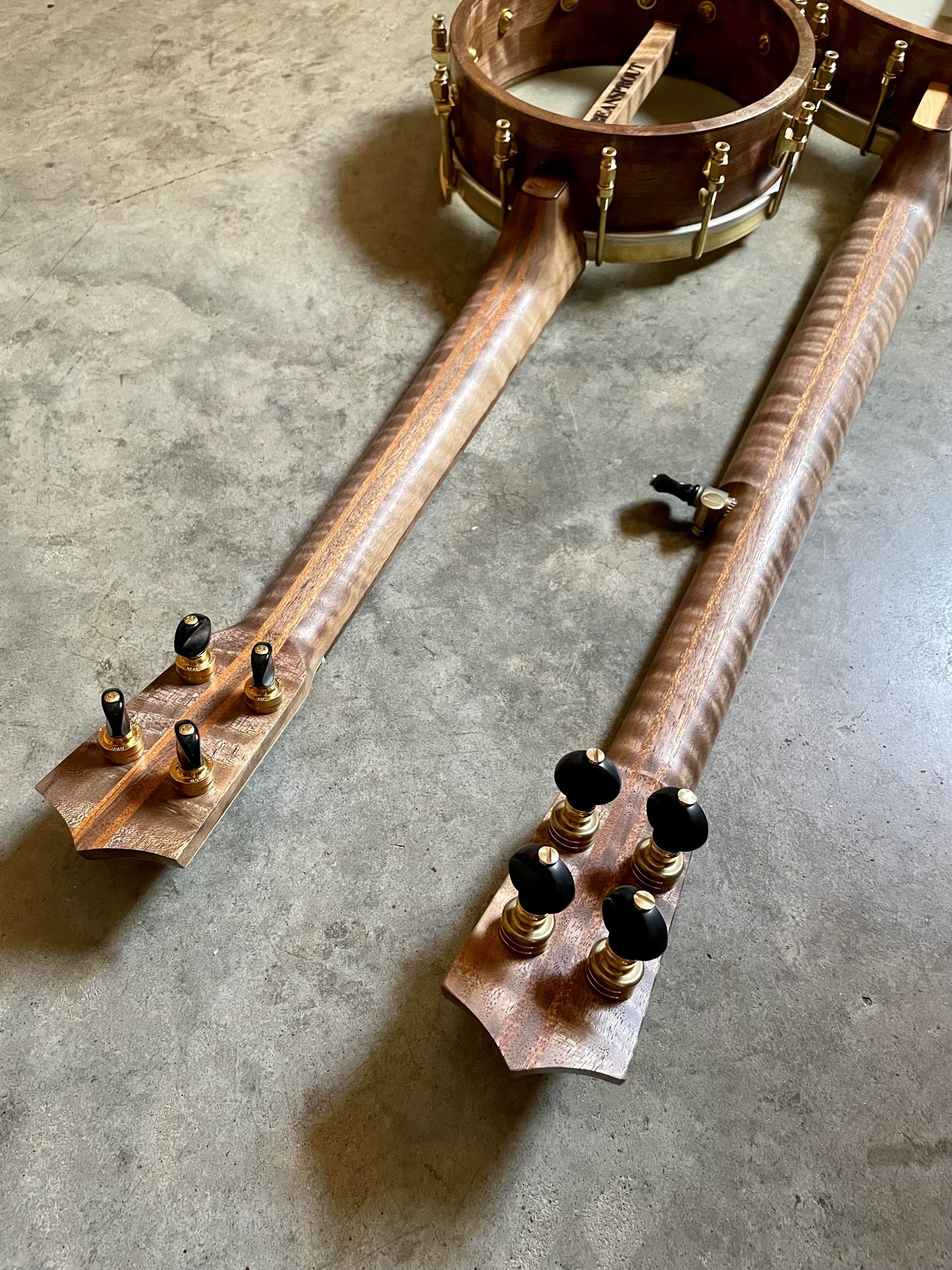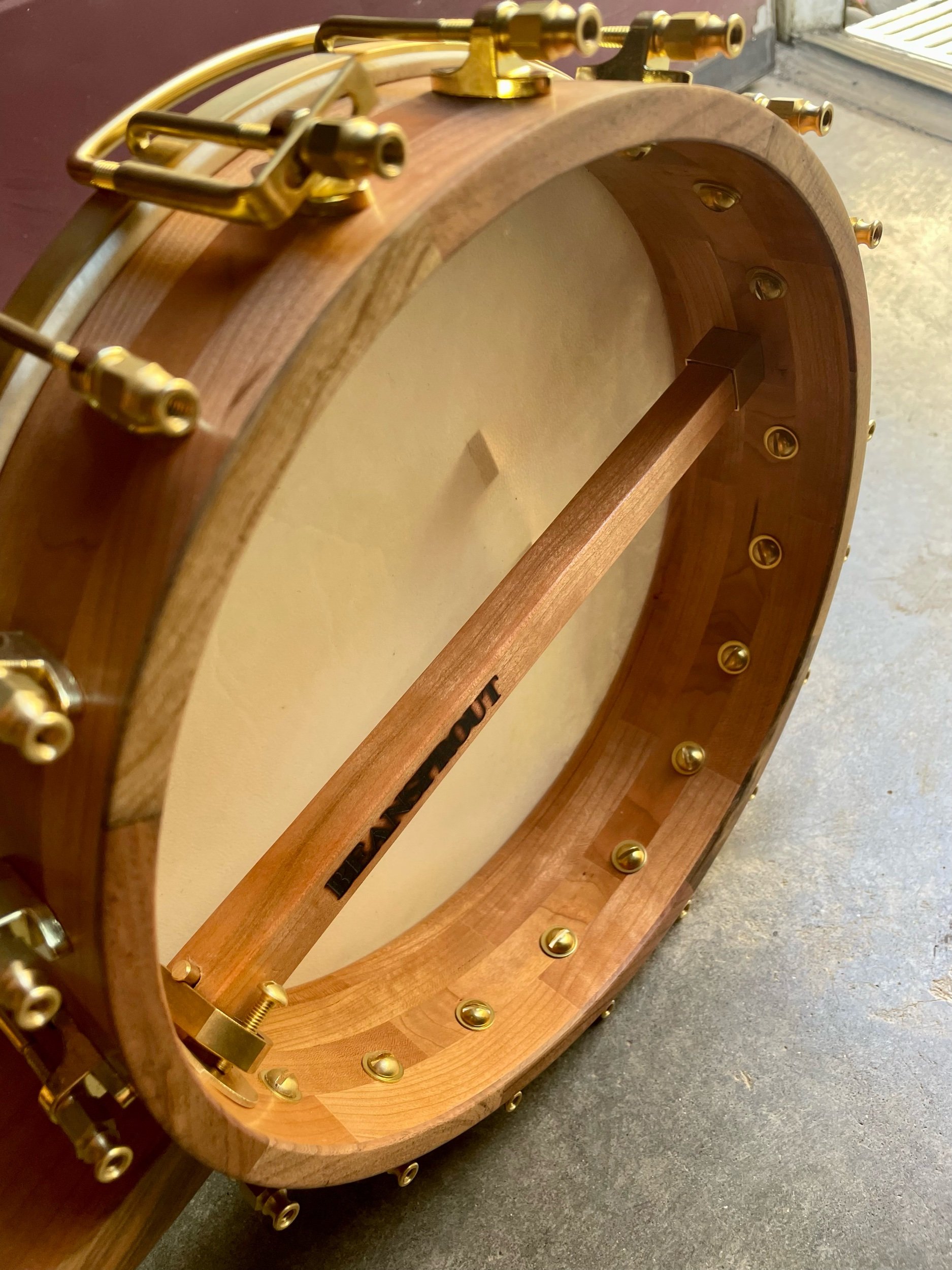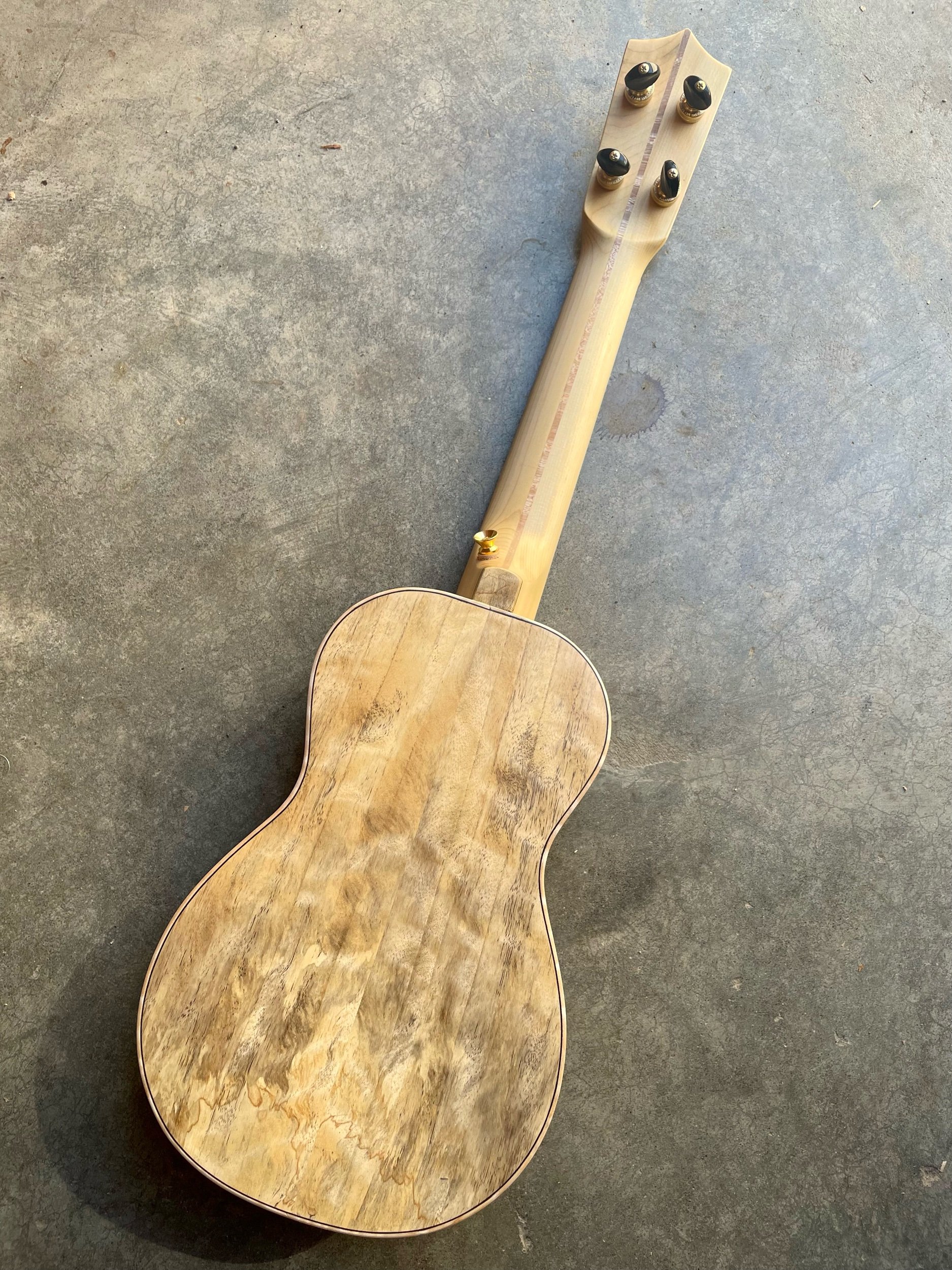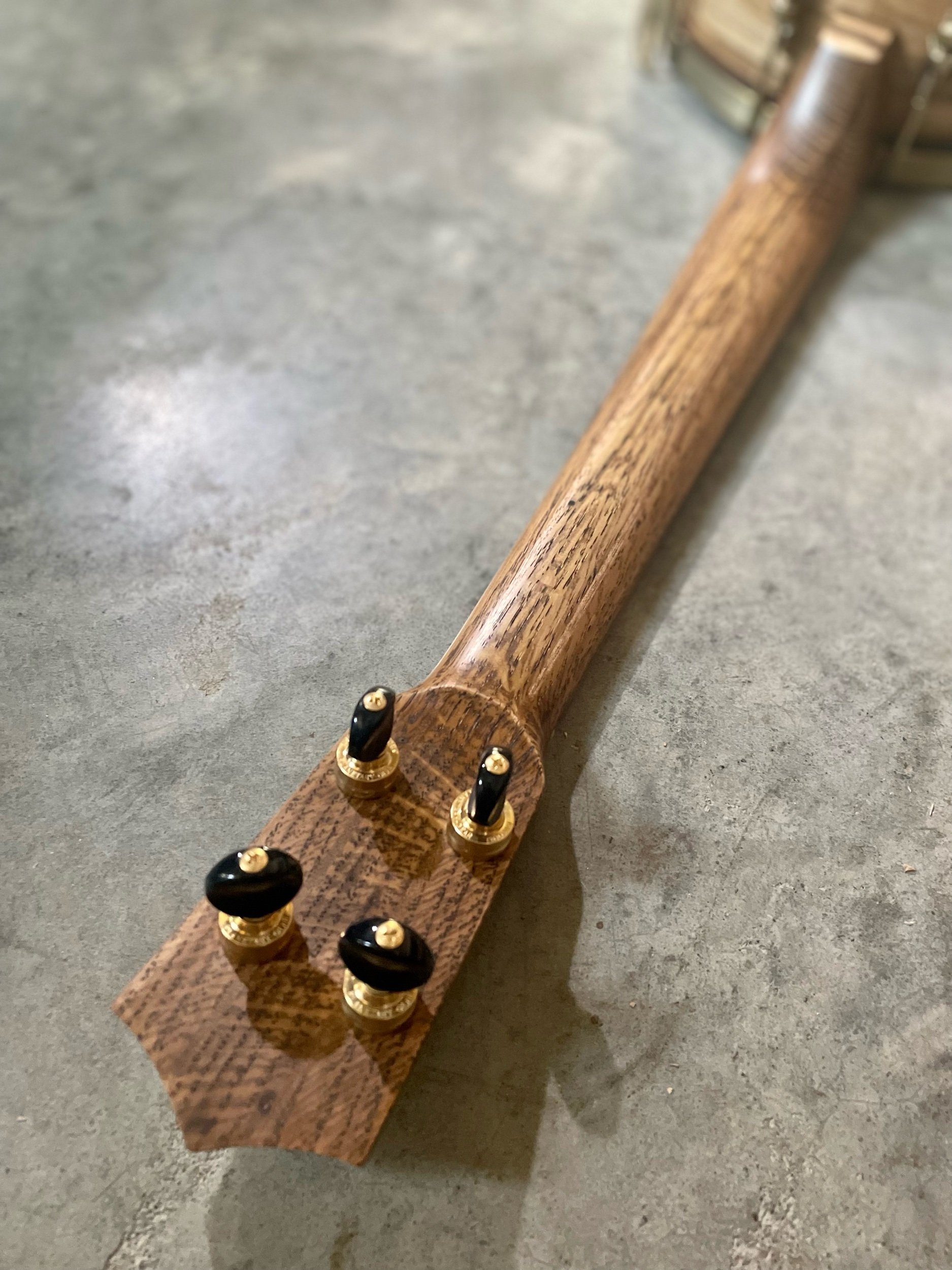A matching pair for a pair of brothers, what a fun project! The bodies are curly Walnut from Southern Oregon, from woodfromthewest.com. Everything else is Texas Ebony from a retired banjo builder. The uke is tenor scale with a Renaissance head and a comfortable arm rest. The banjo has a 12” rim, brass tone ring, Renaissance head and arm rest. I love how they sound together!
#816- Curly Cherry and Texas Ebony Five String Banjo
Cherry and Texas Ebony has been a popular choice lately and it’s obvious why: it looks, feels and sounds great! This one has a 12” rim, non steel strings, goat skin head and a brass tone ring. All the wood for this one comes from a retired banjo builder. Nicole added a little wood burning on the dowel stick. Happy picking and Happy 30th Birthday Jason!
“Hi Aaron and Nicole,
I was ecstatic to receive a Beansprout Banjo as a 30th birthday gift from my wife! It’s a truly special instrument that looks, feels, and sounds great. I’m so grateful for the hard work and the passion you put into building this banjo for me.
Thank you,
- J. G.
”
#818- Cedar and Walnut Alto Ukulele
I love Cedar and Walnut for the rich tone and sustain, but it also has a percussive sound that I find really useful, especially in a smaller ukulele. This Walnut back and sides are from Goby Walnut in Portland and the Red Cedar top is from Chris at The Dee Mill. I chose a Yellow Cedar neck for a color contrast; this Cedar is from the beach at Camp Westwind. The rest is some dark and striped Pistachio from California Orchards. This beauty is headed out to our customer in Finland!
“The uke itself is incredible. I really have to commend the workmanship you put in your instruments. Everything about it is just sublime. I love the rather simple look of the uke with a little bit of elegance from the binding and quirky wood. But it’s really the tone that impresses me most. I’ve been lucky enough to play many excellent quality ukes and this really is right up there with the best. I’m always so impressed when such a small instrument can produce such a big sound. The tone is warm and resonant but still clear with great note separation, just how I like it. And on top of that the playability is sublime which I of course didn’t doubt for one bit. I couldn’t be happier.
I really want to thank you both, not only for providing a brilliant instrument but also making the whole process easy, fun and exciting from start to finish.
Cheers.
Best regards
-E.S. ”
#815- Maple and White Oak Scout Mini Banjo
This banjo follows my “Scout” line of ukuleles, meaning I get to pick the wood, it uses my thin steam bent rims, less metal hardware and a super thin beeswax and oil finish. This makes for a lightweight, vibrant, rustic and lower cost banjo. The Maple from this is leftover from a Colorado cabinet maker which I’ve saved for many years. The Oak is from two places: wine barrels from up the road and a tree from our friend Larry’s property. #815 is headed to Europe for a bicycle trip! Bon voyage!
“I just wanted to express my deepest appreciation for getting me little beansprout to me! I cannot even tell you how much I love it!!!! I adore and treasure this beauty and I can’t stop playing it.
I am so happy happy happy!
- Y. G. ”
#811- Spruce and Myrtle Tenor Ukulele
This is what I am here for: simple lines, natural wood patterns, careful construction, easy playability and big tone. It looks simple from far away but contains endless details. The Spruce is from luthier Craig Wilson, harvested from Vancouver Island. The Myrtle is from the Oregon coast and the Pistachio is from California Orchards, both via woodfromthewest.com. The Fir neck is salvaged from an old floor joist, with a filled nail hole to keep us humble. Happy strumming!
#809- Walnut and Maple Mini Five String Banjo
I use Walnut and Maple frequently, but I think this is the first time I have combined them in this way, mixing them in equal measure all over the instrument. The Walnut is quality straight grain stuff and the Maple is a mix of bird’s eye and curly, all from the Carpenter Ant stash in Portland. It is strung with the heavier strings to get open G tuning, it also sounds great tuned one step higher. The mix of woods made for a vibrant sound that is subtle and a little bit polite compared to my last few mini five strings. I really liked it once I got the chance to play it this week in the shop.
#805- Oak, Cherry and Pistachio Mini Five String Banjo
For banjos, I usually stick to two kinds of wood on a build, but lately some customer requests have pushed me to use three, which has turned out well. In this case, I used Red Oak for the main wood and added Cherry neck stripes, rim cap, heel cap and head plate. For the fretboard we chose a funky Pistachio fretboard that matched the color scheme and I like it. This one is strung low to A tuning and has an arm rest for playability and comfort. It’s got the dusty, rich sound that I expect from Oak and nice volume. The Oak and Cherry are from the Carpenter Ant stash in Portland and the Pistachio is from California orchards.
“I want to thank you for creating such a magnificent instrument. The case is perfect, I don’t know if you had this made for you or it is an off-the-shelf model made for tenor banjo ukuleles but it fits the mini-banjo perfectly. The fretboard is even more beautiful in person than in the photos, and the scoop is so practical. Oak has always been my favorite wood and I am so happy to find a luthier who uses it for banjos. I don’t understand why it is not more commonly used. I almost ordered one of these mini-banjos a few years back but fate stayed my hand and by waiting I was able to get my favorite wood. You are right to describe the sound as dusty. The biggest surprise is the strings. In the past I have had zero luck with non-steel strings but these do the job beyond expectation - the sound and the feel are just what I wanted. I tuned it down to G and it is fine in that tuning. I admit to having some concerns about the scale length being a tad too small but such is not the case. This is very comfortable to play and does not present the problems my full scale banjo does. All in all a well-made work of art that is also a very enjoyable musical instrument. Thank you.
- D. B. ”
#808- Bearclaw Spruce and Curly Koa Tenor Ukulele
Nice. I tried to make it fancy, but it still looks calm and peaceful to me. When I strum it, the sound just explodes! The top is salvaged Bearclaw Spruce from Alaska. The back, sides and fretboard are Curly Koa from Bart’s sawmill on Oahu. The neck is made from Mahogany and Maple scraps from the Carpenter Ant stash in Portland. It is bound in Walnut with Maple purfling. The headplate, pickguard, end graft and heel cap are a scrap wood mosaic of Walnut, Koa and Maple. It has a K&K pickup, low g, bone nut and saddle, geared tuners and radiused fretboard. As with all of our Koa instruments, we will donate a portion of this sale to Saving Hawaii’s Forests.
“Hi, I decided I would take my time before I got back to you on #808. After having played it for months now, I can say that I believe that this is the finest instrument that I own.
It was love at first sight when I saw it in your newsletter and 808’s beautiful sound came through even in the YouTube demo. It sounds incredible in person - loud, clear, and perfectly intonated. I can feel it vibrating with a life of its own when I strum it. I am so, so happy with this ukulele.
Thank you for this beautiful instrument!
- C.H. ”
#802- Cherry and Pistachio Five String Banjo
Cherry seems to have overtaken Walnut in the last year as the wood of choice for banjos with our customers. It’s generally not as loud as maple, but it’s plenty bright and vibrant. It’s not as mellow as Walnut, but has a rich darkness that I like. I made the 11” rim out of cherry blocks and a pistachio decorative layer. The neck is a five piece neck built up of curly cherry and walnut. Pistachio fretboard and headplate add some color to the front. This one has no tone ring, a goat skin head and non steel strings. It feels and sounds great! The cherry from this comes from the Carpenter ant stash in Portland, the Pistachio from California orchards.
#807- Yellow Cedar and Tamarind Alto Ukulele
Once or twice a year a customer asks me to build using their wood. For many reasons, I usually say no, but for this project I said yes. This is a special gift from our customer to his 84 year old father who lives in Puerto Rico. His father had a Tamarind tree in his backyard while growing up and he holds special memories of playing around the tree and eating its fruit. Tamarind is a food crop tree that has spread all around the world in tropical climates. It is often harvested off the forest floor, which allows fungus to grow, making the spalted colors you see. Since I already use a lot of sustainable orchard trees, this seemed to fit my values. I chose a Yellow Cedar top and neck that we harvested off the beach at Camp Westwind in Oregon. It drifted down from Canada and also is spalted. For the fretboard, I thought I should choose another wood that evokes travel and migration, so I made the fretboard from Teak! Teak is an expensive hardwood from Asia that is prized by boat builders. I would never buy it normally, but I found some when cleaning out a corner of the Carpenter Ant stash in Portland. It is dense, stiff and naturally oily. Perfect for fretboards. I’m fact, after my Texas Ebony runs out, this will likely be my dark brown fretboard wood, so stay tuned. Overall I am really pleased with the aesthetics, the sound and the spirit of this uke. I’m honored to be a part of a project like this!
(BTW I accidentally said “bridge” when I meant to say “fretboard” when discussing the Teak on the video. Oops!)
#810- Maple and Oak Concert Banjo Uke
The heart of this project is a steam bent rim from an oak tree from our friend Larry’s property. I usually use a block rim or segmented turning for my rims, but steam bending green wood has been a fun and educational experience this year. The neck and rim cap are maple, while the rest is made of various Oak scraps laying around. I added a pickup and quick and natural oil/wax finish. I’m ready for my gig tonight!
#806- Spruce and Curly Walnut Baritone Ukulele
A baritone should be light and vibrant, but also dependable and solid. It’s a fine line, but I love chasing that balance. This uke has an Englemann Spruce top with some rare color variations. The curly Walnut from Southern Oregon is so beautiful for back sides and some some binding. I have more of it, from Kevin at woodfromthewest.com. The green striped Pistachio for fretboard, headplate and bridge is from California orchards, also via Kevin. The customer added some subtle class with a rope rosette and end graft.
“As I looked for your email today to finally thank you, I noticed that it’s been exactly a year since I placed my order. From then until now, it’s been a great experience. The anticipation of the build, the updates on the process and finally receiving this beauty was second only to the last few of months of playing around with her. What a looker. Great voice. Lovely backside. Pretty face. She’s easy on the eyes for sure. She’s articulate and clear about what she has to say. Of course, she lets me know when I step out of line, though she’s kind and forgiving. She feels smooth and light in my hands and smells wonderful as she lays on my chest. Love her creamy smooth neck and curvy bottom. She’s elegant with a subtle classy way about her. Photos don’t due her justice. At first, I hid this relationship from my wife. I knew she would be jealous, but this sweet thing won her over with her charming personality and lovely songs. I know it’s not just summer love. I’m confident this relationship will last a long time.
- S. C. ”
#800- Kingdom Era Koa Soprano Ukulele
This is the second instrument I’ve made as part of my Kingdom Era Ukulele project, where I have been researching the original instruments made in Hawaii in the 1890’s. I used the same hand tools, techniques and most of the same materials as the instruments I examined in the Bishop Museum and in Shawn’s collection from ukulelefriend.com. The body, neck and fretboard are made from Koa from our friend’s sawmill on Oahu. I made the rope binding from Maple, Cherry, Walnut and Mahogany. It is soprano scale, with a flat fretboard and white side dots. In order to be more comfortable for modern players, I’ve used geared Peghed tuners, fluorocarbon strings and small fret wire. The ukulele is finished with shellac and wax. It comes with a handmade case made in the old style from Mahogany scraps with rope binding and Kapa style cloth.
The sale of this instrument will fund a future research trip to Hawaii, and a portion of the proceeds will go to the non profit Saving Hawaii’s Forests. The sale will be done by auction and you can place your bid here. Thank you!
#803- Walnut and Pistachio Concert Banjo Ukulele
A standard model around here, made with local Walnut and Pistachio from California orchards. It’s just a little guy, but is stout, robust and carefully made. The sound is plenty loud, but also rich and pleasing. You keep asking for them and I’ll keep making them.
“Hi Nicole and Aaron,
I love my Beansprout banjo uke! The walnut and pistachio are beautiful, and it just feels so good to play. I’ve been working on some Clawhammer tunes from Aaron’s book, and also some fingerstyle Ragtime arrangements that sound really great on it. So fun! This is definitely the all-rounder, “great for anything I throw at it” instrument I hoped it would be, and I know I’ll get a lot of joy out of it for a long time. It’s also a privilege to play a handmade instrument of this quality at all, but especially one that was made for me.
It made me smile to find the little feather that was in the gallery photos in the case — it’ll stay there as a reminder of where and who this fine instrument came from!
Thank you so much,
- V. M. ”
#804- Myrtle Alto Ukulele
This simple ukulele is a great example of the aesthetic I strive for. It looks simple and clean, but closer looks and handling reveal small beautiful details. In Japanese culture, this is called “shibui,” which is something I strive for but will never achieve. The lightly Curly Myrtle is from a tree in Portland. The Port Orford Cedar neck was salvaged from a retired flute builder’s shop. The grafted Pistachio is from California orchards. It is light, vibrant, cheerful and subtly rich in tone.
#799- Parkdale Cedar and Walnut Alto Ukulele
This stock alto ukulele was built mainly to test a Cedar stump I milled. I got it from The Dee Mill and it comes from Parkdale, just up the road from here. It is a more contemporary tree than I usually use, with wider grain. But I knew that if I split the log and sawed off the split, I could get well quartersawn tops for stability and tone. I really love the look and sound of it, maybe a bit brighter than closer grain tops. The back and sides are some local Walnut and the neck is Redwood, also from The Dee Mill. The fretboard, headplate, bridge and top binding are some Myrtle from a Portland tree. This one is rustic and wabi-sabi, with a couple of small aesthetic flaws and light scratches in the top which is reflected in the price.
#795- Mastergrade Myrtle Soprano Ukulele
Look at this little friend! What a charmer! The body is some crazy Myrtle from a Portland suburb. It has some dark staining that creeps through the more normal light green. The neck is some Spanish Cedar from a luthier’s estate. The rest is local Walnut. It is loud, light and vibrant. I have more Myrtle like this, if someone is interested.
#798- Oak and Pistachio Tenor Banjo Ukulele
For this project, I started with a board of buggy White Oak from the Carpenter Ant stash in Portland. I stained it to look like Arts and Crafts and Mission style furniture before I applied the finish coats. Billy also wanted the brass darkened and the goat skin head stained, which make for a cohesive look that I really enjoy. It has an arm rest, a low g and a pickup as well. It is loud and rich, with a dusty edge to the tone, which I expect from oak.
“I have had the chance to play the banjo uke a bit more now and I just want to say that I love it as much as I thought I would. I love the tone and the action. It has been greatly admired by the St Albans uke community! Another work of art by Aaron. Thank you.
- B. P. ”
#793- Cedar and Walnut Tenor Ukulele
Wow, we really like how this one sounds. Nicole commented while doing the final quality checks that she just wanted to keep playing it and I fully agree. Cedar and Walnut is a tried and true combo for us and this one doesn’t disappoint. The Cedar top is from a driftwood chunk that Chris from The Dee Mill backpacked off a beach in Washington state. It has lots of beauty marks and character, but so would you if you had been through the same experience. The Walnut back and sides is from a local tree that I harvested myself, I really like the color and curl. The Mahogany neck is scrap from a furniture maker. The rest is Pistachio from California orchards.
“Hi Aaron and Nicole,
My uke arrived yesterday morning and I just wanted to let know I couldn’t be happier - It sounds, feels, and looks so great. It’s so beautiful and has a life of its own. Also, as a born and raised West Coast boy of seventy-four years, I love all the places where the materials come from. My father worked out of Hood River in the 1930’s, I worked summers as a college kid in the San Joaquin Valley (pistachios), and have lived in Washington since the late 60’s. So, this uke feels like it’s a part of me. I started playing the ukulele to sing with kids, when my wife and I opened up our own preschool in 2005. We’re both retired now but I’m still interested in keeping up with playing and learning more.
Thanks for bringing so much integrity and beauty to what you do.
With much appreciation,
C. H. ”
#792- Port Orford Cedar and Sycamore Alto Ukulele
This was a very fun build for me: a simple design, domestic materials and some freedom from the customer to make some decisions on my own. The Port Orford Cedar top is some very old fine grained wood from the Oregon coast. The Sycamore is from the Carpenter Ant stash in Portland, with some beautiful grain that is not too flashy. I used fir and maple shop scraps for the neck and some Pistachio from California Orchards for the fretboard/headplate/bridge. I chose some rope binding for the body and some amber stain under the finish. I think it looks classy and sounds crisp and defined. I have more nice Sycamore like this, let’s do a tenor next!
“Aaron & Nicole,
Many thanks for the Sycamore and Port Orford alto uke #792. I play it daily and someday hope that my playing catches up with its beautiful crisp tone and distinctive style. It has sung at my younger son’s wedding in May and a few other outdoor venues where it blends well with guitar and better voices that mine.
Best regards,
D. H. ”













































































































































